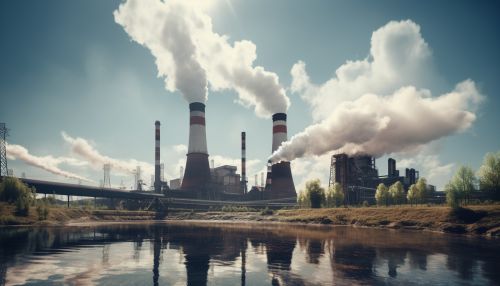Clean coal technology
Overview
Clean coal technology refers to the collection of technologies being developed to mitigate the environmental impact of coal energy generation. These technologies aim to improve the efficiency and reduce the harmful emissions of coal-burning power plants. When coal is used as a fuel source, the gaseous emissions generated by the thermal decomposition of the coal include sulfur dioxide (SO2), nitrogen oxides (NOx), carbon dioxide (CO2), and other chemical byproducts that can cause environmental and health problems. Coal is a fossil fuel that is abundant and inexpensive, making it a significant source of energy, particularly in developing countries. However, its use is associated with significant environmental challenges.
History
The concept of clean coal technology was first proposed in the late 20th century as a response to growing environmental concerns related to coal use. The term "clean coal" was coined to refer to technologies that could reduce the emission of harmful pollutants associated with coal combustion. The development of these technologies has been driven by environmental regulations and the need for more efficient energy production.
Types of Clean Coal Technology
There are several types of clean coal technologies, each targeting different pollutants and efficiency issues.
Coal Washing
Coal washing is a type of clean coal technology that aims to remove impurities from coal before it is burned. The process involves crushing the coal into small chunks and washing it. The impurities in the coal are heavier than the coal itself, so they sink to the bottom of the washing medium and can be removed.
Gasification
Gasification is a process that converts organic or fossil fuel-based carbonaceous materials into carbon monoxide, hydrogen, and carbon dioxide. This is achieved by reacting the material at high temperatures without combustion, with a controlled amount of oxygen and/or steam. The resulting gas mixture is called syngas and is itself a fuel.
Carbon Capture and Storage
Carbon capture and storage (CCS) is a technology that can capture up to 90% of the carbon dioxide emissions produced from the use of fossil fuels in electricity generation and industrial processes, preventing the CO2 from entering the atmosphere. The captured CO2 is then transported and stored underground.
Integrated Gasification Combined Cycle
The Integrated Gasification Combined Cycle (IGCC) is a technology that turns coal into gas, removes impurities from the coal gas before it is combusted, and uses the heat from the coal gas to produce steam that generates additional power. This increases the efficiency of the power plant and reduces the amount of CO2 emissions.
Environmental Impact
While clean coal technologies can significantly reduce the environmental impact of coal use, they are not without their own environmental challenges. The process of capturing and storing CO2, for example, requires energy, which means that power plants equipped with CCS technology are less efficient than those without it. Additionally, the storage of captured CO2 presents potential environmental risks, particularly if the storage sites leak.
Economic Considerations
The cost of clean coal technologies is a significant barrier to their widespread adoption. While these technologies can reduce the environmental impact of coal use, they also increase the cost of coal-fired power generation. This has led to a slow uptake of these technologies, particularly in developing countries where the cost of energy is a significant concern.
Future of Clean Coal Technology
The future of clean coal technology is uncertain. While these technologies have the potential to significantly reduce the environmental impact of coal use, their high cost and the availability of cheaper, cleaner alternatives may limit their adoption. However, as long as coal remains a significant source of energy, there will be a need for technologies to reduce its environmental impact.
See Also


